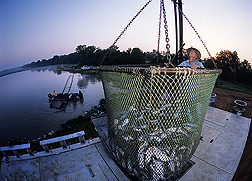This page has been archived and is being provided for reference purposes only. The page is no longer being updated, and therefore, links on the page may be invalid.
Read the magazine story to find out more. |
|
|
Genetic Findings Could Boost Catfish Quality and Grower Profits
By Alfredo FloresJanuary 29, 2007
Traditionally, the catfish is looked upon as a bottom-dweller. However, the farm-raised catfish is the most important fish in U.S. aquaculture, and Agricultural Research Service (ARS) scientists are working to improve its potential.
By unlocking the secrets of the catfish genome—its total genetic information—researchers at the ARS Catfish Genetics Research Unit (CGRU) in Stoneville, Miss., are looking for the best way to select catfish broodstock with superior genetic qualities. In Mississippi alone, catfish production is worth about $245 million annually, so there is keen interest in improving the industry's efficiency.
The catfish genome, about one-third the size of the human genome, contains about one billion bases of genetic material called DNA. Led by CGRU molecular biologist Geoff Waldbieser, geneticist Brian Bosworth and molecular biologists Dan Nonneman and Sylvie Quiniou used high-throughput DNA technology to identify tens of thousands of active catfish genes and nearly 10,000 variable DNA sequences called "microsatellites." Now they're searching for favorable, natural variations within genes that control important traits such as lean growth, carcass yield and improved survival in commercial ponds.
Finding the first catfish microsatellite sequences allowed Waldbieser to develop a DNA fingerprinting system. That was a crucial first step toward identifying distinct genetic populations, because all channel catfish look very much alike. By using several selected microsatellites as DNA markers, Waldbieser was able to identify the parents of egg masses, or "spawns," collected from ponds and determine which individual catfish reproduced.
Prior to this discovery, researchers could only know that certain broodfish were in a pond, but they couldn't tell which fish were parents of the spawn they collected. The DNA technology enabled the researchers to identify same-year spawns that were related to the same father.
Waldbieser and Nonneman—who is now at the ARS Meat Animal Research Center in Clay Center, Neb.—teamed with researchers at the University of Mississippi Medical Center at Jackson, Mississippi State University's College of Veterinary Medicine, and Auburn University in Alabama to identify more than 40,000 expressed catfish genes. That collaboration will soon produce several hundred thousand more catfish DNA sequences for public use.
Read more about this research in the January 2007 issue of Agricultural Research magazine.
ARS is the U.S. Department of Agriculture's chief scientific research agency.

